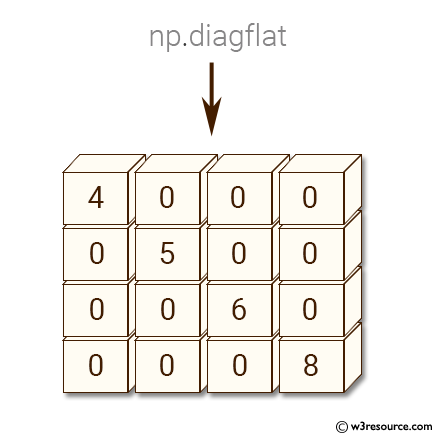NumPy: Create a 2-D array whose diagonal equals
2D Array with Custom Diagonal Values
Write a NumPy program to create a 2-D array whose diagonal equals [4, 5, 6, 8] and 0's elsewhere.
Pictorial Presentation:

Sample Solution:
Python Code:
# Importing the NumPy library with an alias 'np'
import numpy as np
# Creating a 2-D array with the specified diagonal elements and zeros elsewhere
x = np.diagflat([4, 5, 6, 8])
# Printing the resulting 2-D array
print(x)
Sample Output:
[[4 0 0 0] [0 5 0 0] [0 0 6 0] [0 0 0 8]]
Explanation:
This code demonstrates how to create a diagonal matrix using the np.diagflat() function in NumPy.
x = np.diagflat([4, 5, 6, 8]): The current line creates a diagonal matrix ‘x’ using the np.diagflat() function. The function takes one argument, which is a list or array-like object containing the values to be placed on the diagonal of the resulting matrix.
print(x): The current line prints the diagonal matrix ‘x’.
For more Practice: Solve these Related Problems:
- Create a square 2D array of zeros and then replace its diagonal with custom values from a given list.
- Write a function that accepts an array of diagonal values and outputs a matrix with those values on its diagonal.
- Validate the custom diagonal by comparing each diagonal element to the expected value.
- Handle edge cases where the number of diagonal values does not match the matrix size and raise an error.
Go to:
PREV : 3D Array with Diagonal Ones
NEXT : 1D Array (0–50) & (10–50)
Python-Numpy Code Editor:
Have another way to solve this solution? Contribute your code (and comments) through Disqus.What is the difficulty level of this exercise?
Test your Programming skills with w3resource's quiz.
